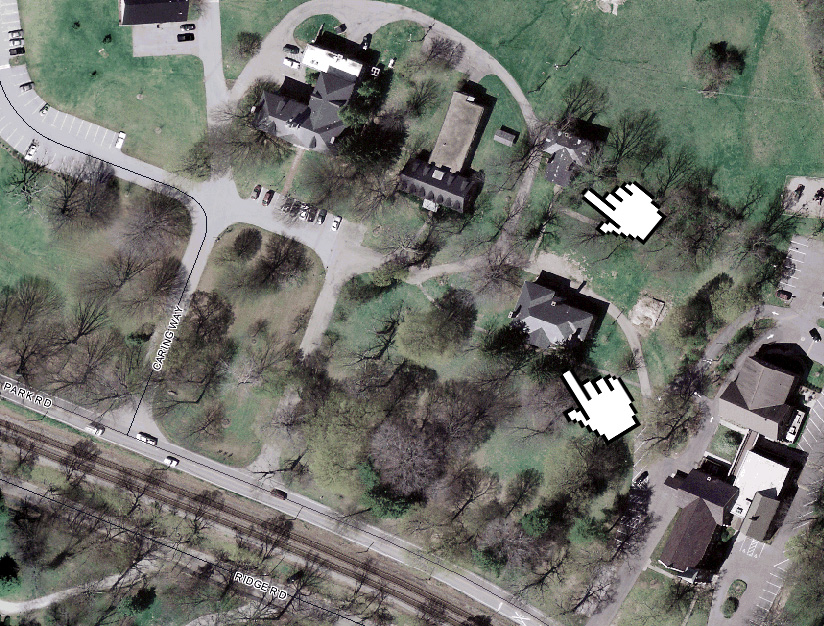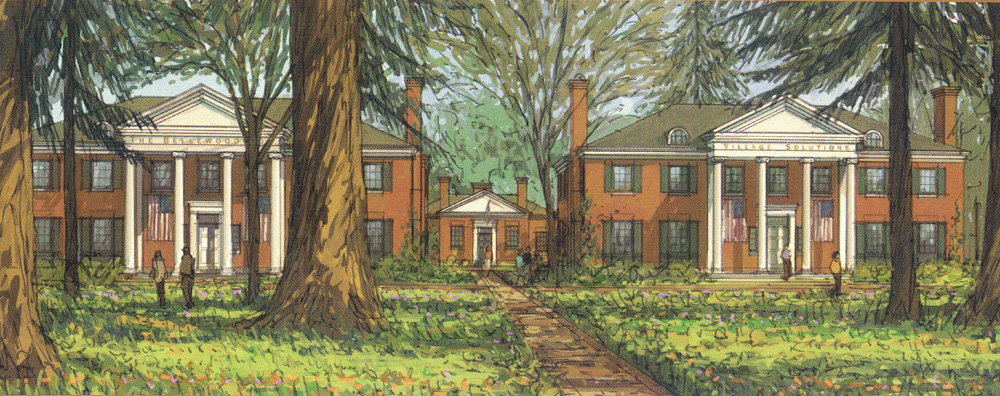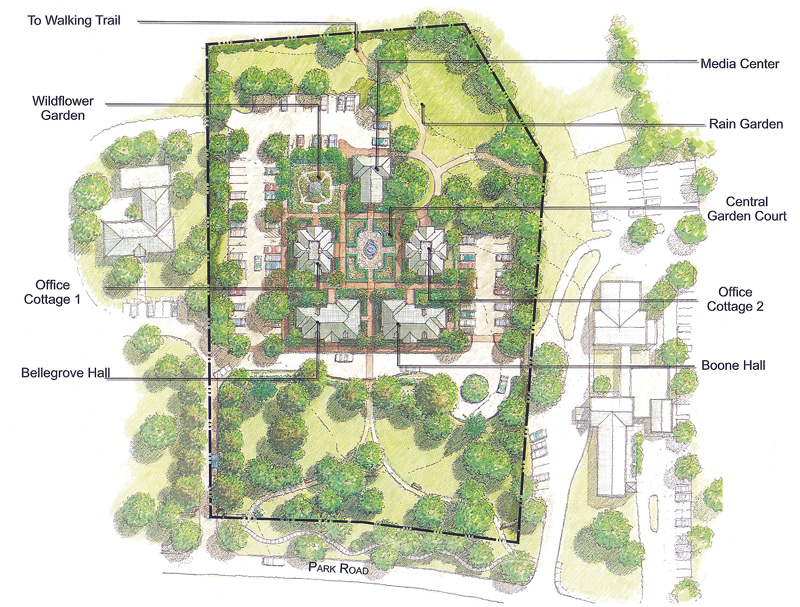There’s more development activity set for downtown Anchorage, which has been slowly transforming itself over the last couple of years. This time, Village Solutions plans to convert two historic structures and build several new buildings in an effort to create a unique office development centered around a formal English courtyard. The property once belonged to Belleview Home, but was recently sold for redevelopment.
Village Solutions plans to eventually build three new Jeffersonian-style structures to match the historic architecture, anchored by Boone Hall, the original girl’s dormitory at Bellwood. The development, dubbed Bellegrove strives to preserve and protect the environment and create an abundance of green space and gardens. Developer Rick Hill envisions 5 buildings in a botanical garden setting with groves of 100 year old trees all around. Already, a creative center is finishing up construction and a reproduction facility for large-format graphics and printing is planned.
Plans call for leaving much of the 4.5 acre site open. A large “outdoor living room” will link the new structures, that, when complete, could encompass around 22,000 square feet. The site could have supported more than double the space under conventional development standards, but Hill wanted to create a special project for the historic neighborhood. He studied the original layout of the buildings to maintain a perceived master plan following Olmsted principles.
Boone Hall, built in the 1930s, has an elaborate Greek-revival facade, and a twin two-story building will be built to its side to create formal symmetry on site and reinforce a perspective toward the original Bellewood laundry facility which is also being renovated. Bellegrove will feature high-quality materials in its renovation and new construction including copper gutters and slate roofs. Rick Hill noted that the new construction will not mimic the old, but be held to the same high standards.

The project aims to be a model in handling rainwater runoff. Throughout the site, pervious brick paving will allow water to seep back into the ground, away from storm sewers. The remaining water runoff will be channeled into a wildflower and prairie grass garden with a gazebo. Hill speculates that this garden will be the largest prototype rain garden in the region and plans teaching classes where rainwater design issues will be discussed.
The initial phases of the project are expected to open by Derby this year, and a series of community events are planned around its opening. New construction will take place over time as the markets allow and office suites are for sale and lease. Spaces range from large suites to small “craftsmen cottages.” Rick Hill sees other development in Anchorage, most notably the new commercial district build by John Schnatter’s Evergreen Real Estate, as reinforcing a greater whole. The nearby walking trails and cafes will only benefit his project.
We’re glad the project reuses the historic structures and offers the potential for neighbors to work close to home. Combined with other development in the area, Anchorage is quickly becoming a walkable neighborhood, even with its park-like, rural nature. Emphasis of the formal English garden and rain gardens as a project focal point should also help highlight small scale methods of diverting rainwater runoff from our overwhelmed sewer system.
- Village Solutions Company (Official Site)
- Development Watch: The New Face of Anchorage (Broken Sidewalk)
- It takes a village: company profile (Business First)








i can’t come up with anything better to say than ‘ick’ – and i haven’t had my coffee yet – so i’ll leave it to some others smarter than me:
“Context is a matter of time as well as place.” – Herbert Muschamp
“Let us be clear about this, the forms that people used in other civilizations or in other periods of our own country’s history were intimately part of the whole structure of their life. There is no method of mechanically reproducing these forms or bringing them back to life; it is a piece of rank materialism to attempt to duplicate some earlier form, because of its delight for the eye, without realizing how empty a form is without the life that once supported it. There is no such thing as a modern colonial house any more than there is such a thing as a modern Tudor house.
“If one seeks to reproduce such a building in our own day, every mark on it will betray the fact that it is a fake, and the harder the architect works to conceal that fact, the more patent the fact will be…The great lesson of history – and this applies to all the arts – is that the past cannot be recaptured except in spirit. We cannot live another person’s life; we cannot, except in the spirit of a costume ball…Our task is not to imitate the past, but to understand it, so that we may face the opportunities of our own day and deal with them in an equally creative spirit.” – Lewis Mumford, 1941.
And, finally, a response to Mumford: “…It is a scathing and still relevant (perhaps now more than ever) comment which cuts to the heart of a common misperception that we can replicate the past in buildings we build today and, in doing so, we are achieving something worthwhile, or even paying homage to the past…By spending time, money, and other resources trying to replicate the past, we are not paying homage, but rather we are betraying the people who worked so hard in those times to provide us with an architecture that spoke of those periods. These men and women, pioneers of their time, would look at us with dismay as we fail to reinvent, redesign, and create our architecture and housing forms based on today’s environmental, social, and cultural needs.” –R Sethi, 2007.
While I completely agree with the words of Mumford and Muschamp that you quoted, I do not believe their comments are relevant to this project. From my experience reading articles by those famous men, what they were criticizing was the reproduction of historic buildings. This has been done over the years in attempt to reproduce the feeling and lives of those that inhabited such structures. Criticisms such as these have been laid on many New Urbanist plans, such as our local Norton Commons, for creating what some call the ‘Disney effect’.
In the case of Bellegrove I do not think it is appropriate to lay such criticisms on the project. The project maintains some of the historic structures and creates several others using the materials and styles of the existing property and surrounding neighborhood, but for a completely different purpose than to create a false ‘step back in time’. As Mr. Hill stated in the article, “the new construction will not mimic the old, but be held to the same high standards.” If current practices and styles were used on the project it would most likely result in the new buildings looking out-of-place within the neighborhood, or even worse could detract from what really makes Anchorage a lovely place, the established natural surroundings. The fact that he is utilizing the site so as to best minimize the impact on the environment should be applauded. I agree with the authors that designers and developers should be true to their time, but in an area where the vast majority of homes and buildings are from a specific time period I think that should be respected so as to not disrupt the character of the neighborhood. I will close in saying that I am not affiliated in anyway with the developer nor do I live in the area- these are just my personal opinions.
yes, we’ll just disagree then. a false step back in time is exactly what it seems to me.
here in the states we worry so much about ‘fit’ that we make a lot of anemic copies to set next to the originals. while in so many other countries the architecture of different times is allowed to coexist so much more naturally/casually > honestly.
the integrity of the older architecture is honored by new architecture which also has integrity – not by new construction which mimics. and, yes, mimicry is what these renderings illustrate, not just similar “high standards”. i bet they’re not doing their 21st century colonial with load-bearing multi-wythe brick, plaster on lath, blown glass in wood windows…and where is the right place to put a condensing unit outside a colonial structure? or will the buildings be cooled by opening windows and heated by wood fires like those after which they’re modeled? let’s just hope the shutters are real and not screwed to the wall.
the only good i see here is that it appears that the designers have at least learned how to use the elements of the style correctly. so many don’t…
[…] much ignored by the Courier-Journal and Business First, Bellegrove was covered by Broken Sidewalks in 2009, which detailed Hill’s progressive Green plans for porous surfaces to control rainwater […]